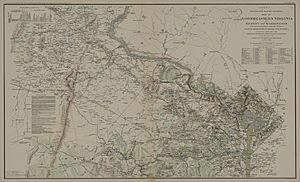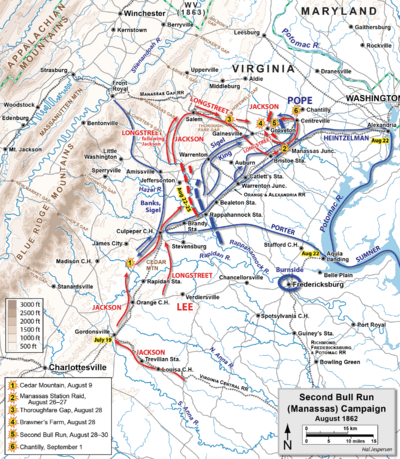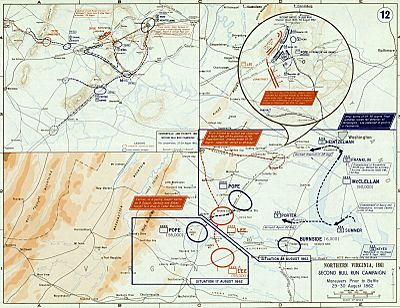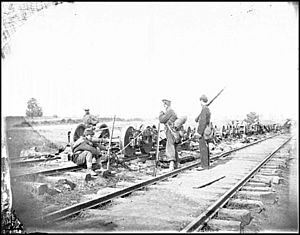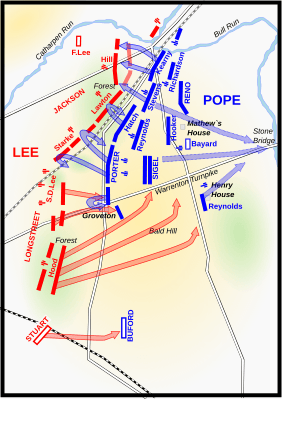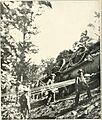Northern Virginia campaign facts for kids
Quick facts for kids Northern Virginia campaign |
|||||||
|---|---|---|---|---|---|---|---|
| Part of the American Civil War | |||||||
 John Pope and Robert E. Lee, commanding generals of the northern Virginia campaign |
|||||||
|
|||||||
| Belligerents | |||||||
| Commanders and leaders | |||||||
| John Pope | Robert E. Lee | ||||||
| Units involved | |||||||
|
Army of Northern Virginia | ||||||
| Strength | |||||||
| 75,000 | 48,500 | ||||||
| Casualties and losses | |||||||
| 16,843
(2,061 killed;
9,897 wounded; 4,885 missing/captured) |
9,197
(1,481 killed;
7,627 wounded; 89 missing/captured) |
||||||
The Northern Virginia campaign was a series of important battles. They were fought in Virginia during August and September 1862. This campaign was part of the American Civil War.
Confederate General Robert E. Lee led his army north. He had just won battles in the Peninsula campaign. His goal was to move towards Washington, D.C.. Lee defeated Union General John Pope and his Army of Virginia.
Lee was worried that Pope's army might join with General George B. McClellan's army. If they combined, Lee's army would be greatly outnumbered. So, Lee sent General Thomas J. "Stonewall" Jackson north. Jackson's job was to stop Pope's advance.
The first fight happened at Cedar Mountain on August 9. The Confederates won this battle. Lee then realized McClellan's army was no longer a threat to Richmond. He sent most of his remaining army, led by General James Longstreet, to join Jackson.
Jackson made a wide move around Pope's army. He captured a large supply base at Manassas Junction. This put his forces between Pope and Washington, D.C. Jackson then took a strong defensive spot near the 1861 First Battle of Bull Run battlefield.
On August 29, Jackson successfully fought off Union attacks. Lee and Longstreet's forces arrived to help. On August 30, Pope attacked again. But he was caught between attacks from both Longstreet and Jackson. Pope's army had to retreat with many losses. The campaign ended with another move by Jackson. Pope fought him at the Battle of Chantilly on September 1.
Many historians believe Lee's actions in this campaign were brilliant. It is seen as one of his greatest military achievements.
Contents
Background to the Battles
I have come to you from the West, where we have always seen the backs of our enemies, from an army whose business it has been to seek the adversary, and to beat him to when he was found; whose policy has been to attack and not defense.... Let us look before us, and not behind. Success and glory are in the advance; disaster and shame lurk in the rear.
Military Situation in 1862
After General McClellan's campaign failed, President Abraham Lincoln chose John Pope to lead the new Army of Virginia. Pope had won battles in the western part of the war. Lincoln wanted a general who would attack more often than McClellan.
Pope was not very popular with his officers. He often boasted that soldiers from the West were better than those from the East. This made some of his Eastern officers dislike him. However, some of his soldiers liked his aggressive attitude.
The Union Army of Virginia was formed on June 26, 1862. It was made up of different groups of soldiers already in Virginia. Many of these groups had recently been outsmarted by Jackson's forces. The new army had about 51,000 men. It was divided into three main parts, called corps.
Later, parts of McClellan's army joined Pope. Also, General Ambrose Burnside's forces joined. This made Pope's total strength about 77,000 soldiers.
On the Confederate side, General Robert E. Lee's army had about 55,000 men. It was split into two main groups. One was led by General James Longstreet. The other was led by General Stonewall Jackson. General J.E.B. Stuart led the cavalry, which worked with Jackson's group. This simpler organization helped Lee's army work better together.
War Plans and Goals
Pope's main goals were to protect Washington, D.C., and the Shenandoah Valley. He also wanted to draw Confederate forces away from McClellan. Pope tried to do this by moving towards Gordonsville. He sent cavalry to destroy a key railroad there. But Stonewall Jackson had already arrived in Gordonsville with over 14,000 men.
Pope also had a new, tougher approach to the war. President Lincoln encouraged this. For the first time, the Union planned to make life harder for Confederate civilians. Pope ordered his army to "subsist upon the country." This meant they could take food and supplies from farms. Farmers would get vouchers, but only "loyal citizens" would be paid back after the war. Some soldiers saw this as permission to steal.
Pope also dealt with Confederate guerrillas. These were fighters who attacked Union troops from behind their lines. Pope ordered that any house used to shoot at Union troops should be burned. The people inside would be taken as prisoners. These orders were very different from McClellan's way of fighting. Confederate leaders were very angry. Robert E. Lee called Pope a "miscreant."
Lee believed McClellan would not attack Richmond again. This allowed Lee to move most of his army away from the city. He sent Jackson to Gordonsville to stop Pope. Lee had a bigger plan: to defeat Pope's army before McClellan's army could join him.
First Moves of the Armies
On July 26, Lee met with a cavalry leader named John S. Mosby. Mosby had just been released as a prisoner. He had seen Union ships moving many soldiers. He realized these were General Burnside's troops, coming to help Pope. Lee wanted to act quickly before these new troops arrived.
The next day, Lee sent General A.P. Hill with 12,000 men to join Jackson. Lee also made small attacks to keep McClellan busy. McClellan moved some forces, but then pulled them back. He still thought he was outnumbered. He told Washington he needed 50,000 more men to attack Richmond again.
On August 3, General-in-Chief Henry W. Halleck ordered McClellan to leave the Peninsula. He was to move his army back to Northern Virginia to help Pope. McClellan protested, but he started moving his troops on August 14.
Opposing Forces
Key Battles and Movements
On July 29, Pope moved his headquarters closer to the fighting. He knew he was supposed to meet McClellan's army. But instead of waiting, he moved some of his forces near Cedar Mountain. From there, he could send cavalry to attack Gordonsville. Jackson moved his troops to Culpeper Court House on August 7. He hoped to attack one of Pope's groups before they all came together.
Battle of Cedar Mountain
On August 9, General Nathaniel Banks's Union forces attacked Jackson at Cedar Mountain. They gained an early lead. A Confederate general, Charles S. Winder, was killed. His division suffered heavy losses. But a Confederate counterattack, led by General A.P. Hill, pushed Banks back.
Jackson's advance was stopped by another Union division. By now, Jackson realized that all of Pope's forces were together. His plan to defeat them one by one had failed. Jackson stayed in position until August 12, then pulled back to Gordonsville.
Lee Moves to the Rappahannock River
On August 13, Lee sent Longstreet's forces to help Jackson. The next day, Lee sent almost all his remaining troops north. He was sure McClellan was leaving the Peninsula. Lee arrived at Gordonsville on August 15 to take command.
Lee gathered his army south of Clark's Mountain. He planned a turning movement to defeat Pope. He wanted to do this before McClellan's army could arrive. His plan was to send his cavalry and then his whole army north. They would cross the Rapidan River on August 18. They would be hidden by Clark's Mountain. The cavalry would destroy a railroad bridge and then move behind Pope's army. This would cut off Pope's supplies and escape routes. But problems with supplies and cavalry delays made Lee change his plan.
On August 20–21, Pope pulled his army back to the Rappahannock River. He knew about Lee's plan because Union cavalry had captured a copy of Lee's orders. During this raid, General Stuart almost got caught. He lost his cloak and feathered hat. Stuart got revenge on August 22. He raided Pope's headquarters and captured Pope's dress coat. Stuart's raid showed that the Union army's right side was open to a flanking move. Heavy rains caused the river to flood, making it harder to cross. The raid also showed Lee that Pope's army would soon be much larger. It would have 130,000 men, more than twice Lee's army.
Fights Along the Rappahannock
From August 22 to 25, the two armies fought small battles along the Rappahannock River. These included fights at Waterloo Bridge and Freeman's Ford. Hundreds of soldiers were hurt. These skirmishes kept both armies focused on the river. Heavy rains had made the river too high for Lee to cross easily. Pope thought about attacking across the river, but the high water stopped him too.
By this time, more Union soldiers from McClellan's army were arriving. Lee's new plan was to send Jackson and Stuart with half the army on a long march. They would go around Pope's army to cut off his supply line. This was the Orange & Alexandria Railroad. Jackson left on August 25. He reached Salem (now Marshall) that night.
Raid on Manassas Station
On the evening of August 26, Jackson's forces went around Pope's right side. They passed through Thoroughfare Gap. Jackson's army then attacked the Orange & Alexandria Railroad at Bristoe Station. Before dawn on August 27, they marched to capture and destroy a huge Union supply base. This base was at Manassas Junction.
This surprise move forced Pope to quickly retreat from his river defense line. On August 27, Jackson's troops defeated a Union brigade near Bull Run Bridge. Their commander was badly wounded. A Confederate division fought a strong rear-guard action against Union forces. This fight caused about 600 casualties. The Confederates held back the Union troops until dark. During the night, Jackson marched his divisions north. He went to the First Bull Run battlefield. There, he took up a strong position behind an unfinished railroad line. Pope did not know where Jackson had gone.
Thoroughfare Gap Battle
On August 28, Union forces fought near Chapman's Mill in Thoroughfare Gap. A Confederate group went around the Union division. They passed through Hopewell Gap, a few miles north. Other Confederate troops secured the high ground at Thoroughfare Gap. The Union division had to retreat.
This allowed Longstreet's part of Lee's army to march through the gap. They joined Jackson on the Manassas battlefield. This action was very important. It meant Lee's two main army groups could unite. This made Pope's defeat almost certain in the battles that followed.
Second Bull Run (Manassas) Battle
The most important battle of the campaign was the Second Battle of Bull Run. It was fought from August 28–30. Jackson wanted to draw Pope's army into a fight. So, on August 28, he attacked a Union column moving across his front. This showed Pope where Jackson was. The fight lasted several hours and ended in a draw.
Pope became convinced he had trapped Jackson. He gathered most of his army to attack Jackson. On August 29, Pope launched many attacks against Jackson's position. Jackson's troops were behind an unfinished railroad line. The attacks were pushed back. Both sides suffered many losses. At noon, Longstreet arrived from Thoroughfare Gap. He took a position on Jackson's right side.
On August 30, Pope attacked again. He seemed unaware that Longstreet's large force was now on the field. Confederate artillery fired heavily on a Union attack. Then, Longstreet's 28,000 men launched a huge counterattack. This was one of the largest mass attacks of the war. The Union army's left side was crushed. They were pushed back to Bull Run. Only a strong Union rear-guard action stopped a complete disaster, like the one at the First Bull Run. Pope's retreat was very fast. The next day, Lee ordered his army to chase the retreating Union army.
Battle of Chantilly
Jackson made a wide march to try and cut off the Union retreat from Bull Run. On September 1, near Ox Hill, Jackson sent his divisions against two Union divisions. These were led by Generals Philip Kearny and Isaac Stevens. Confederate attacks were stopped by fierce fighting. A severe thunderstorm made conditions even worse. Both Union Generals Stevens and Kearny were killed. Pope realized his army was still in danger. He ordered the retreat to continue all the way to Washington, D.C.
After the Campaign
The Northern Virginia campaign was costly for both sides. Lee's smaller army used its resources very wisely. The Union army had about 16,054 casualties. This included 1,724 killed and 8,372 wounded. The Confederates had 9,197 casualties. This included 1,481 killed and 7,627 wounded.
The [Army of Northern Virginia] acquired that magnificent morale which made them equal to twice their numbers, & which they never lost even to the surrender at Appomattox. And [Lee's] confidence in them, & theirs in him, were so equal that no man can yet say which was greatest.
This campaign was a great success for Lee and his two main generals, Jackson and Longstreet. Historian John J. Hennessy called it Lee's greatest campaign. He said Lee perfectly balanced bold actions with careful planning. Jackson's march around the Union army was amazing. He moved 54 miles in 36 hours behind the Union lines. This was "the boldest maneuver of its kind during the war." Longstreet's attack on August 30 was "timely, powerful, and swift." It came very close to destroying a Union army.
Pope was outsmarted by Lee. He was almost trapped in Washington. Because of his close ties to President Lincoln, his military career was not completely ruined. He was sent to Milwaukee, Wisconsin. There, he commanded the Army's Department of the Northwest. He fought in the Dakota War of 1862. General George B. McClellan took command of all Union forces around Washington. His Army of the Potomac took in the soldiers from the Army of Virginia. The Army of Virginia was officially ended on September 12, 1862.
With Pope no longer a threat, Lee turned his army north on September 4. He crossed the Potomac River and invaded Maryland. This started the Maryland campaign. It led to the battles of Harpers Ferry, South Mountain, and Antietam.
The battlefields of Bull Run are now preserved by the National Park Service. They are part of Manassas National Battlefield Park.
Images for kids
See also
 In Spanish: Campaña del Norte de Virginia para niños
In Spanish: Campaña del Norte de Virginia para niños



